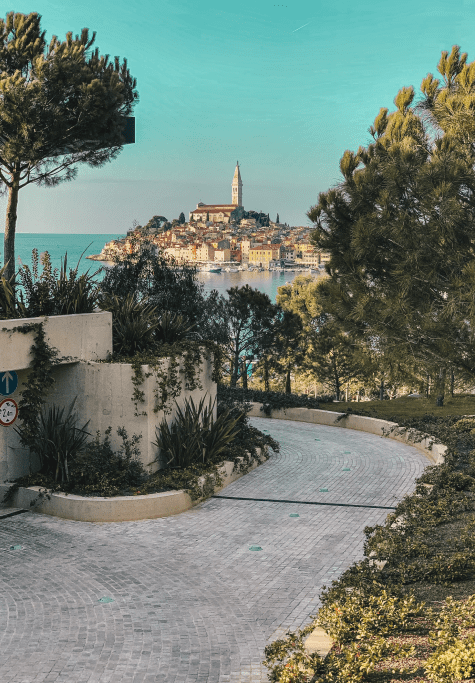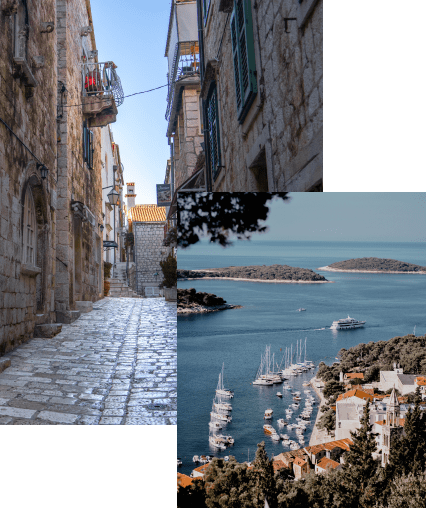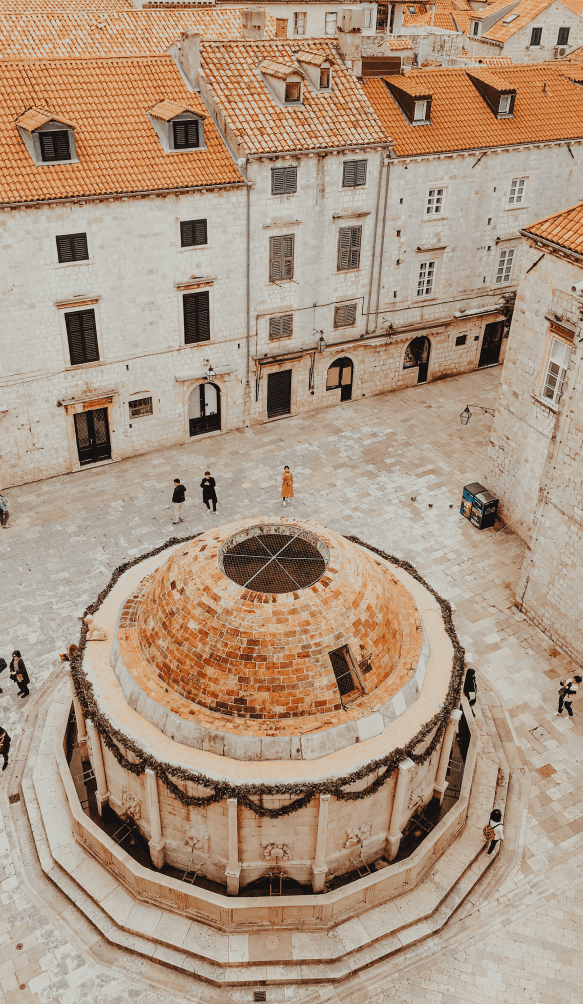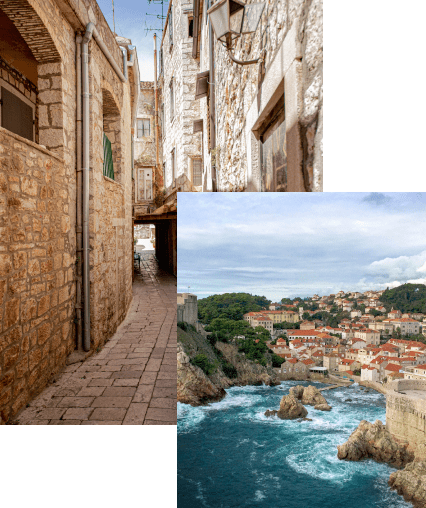Workation » Best Workation Locations and Why You Should Visit Them » Croatia » 11 Best Walkable Cities and Towns in Croatia
11 Best Walkable Cities and Towns in Croatia
Rich history becomes tangible and natural beauty becomes accessible when exploring Croatia’s best walkable cities and towns. When on the cobblestone roads or lingering on the edge of a street overlooking a steep coastal ledge, the uniqueness of Croatia comes to light.
Walking is a way to tour a city or town that immerses you in the setting. When walking, you can smell the sea air, make a sudden step into a boutique shop, or suddenly stop to enjoy a surprising view. Walking a new city or town is a way to orient yourself to the design, uncover hidden artwork, or find a charming restaurant only locals know.
Walking as a form of exploration yields great rewards in Croatia, with Roman ruins, sparkling Adriatic waters, and the invigorating jade color of nearby olive groves. There is a surprise waiting around every corner, no matter how larger or small the city borders. Our list represents the cities and towns where walking reveals the most inviting and exciting atmospheres.


Zagreb
Zagreb is Croatia’s capital city, the political heart of the nation, and also the center for contemporary culture across the country. The energetic pace thrums through the streets and shines in the restaurants, cafes, bars, and unique museum themes, each demonstrating a specific contribution to the city’s lifestyle. The variety of elements that create Zagreb’s particular personality also add to the importance of walking when visiting.
Even as a capital city, Zagreb is a fantastic place to walk the streets to visit historical churches, find desirable cafes, or learn about the distinctive differences between Upper Town and Lower Town. Stroll alongside medieval architecture and the parliament building or travel the Tkalciceva Street where boutique shops and stylish restaurants line the walkway. The marketplace, brightly colored roof tiles, and elaborate frescoes layer each discovery with meaning, heritage, and the little idiosyncrasies that otherwise go unnoticed.
Dubrovnik
Dubrovnik is often referred to as the Pearl of the Adriatic and its walkability only makes it more of a treasure. Historic wealth and the preservation of history are visible in the inticate details found inside of Old Town, whose streets are still protected by the dramatic city walls. The impressive architectural feat possesses ornate gates, intermittent towers, and tremendous views that spread over the orange-tiled rooftops and the turquoise colors of the Adriatic Sea.
The city has become emblematic of the Dalmatian Coast’s beauty, with picturesque cobblestone alleyways and massive cathedrals that speak to their importance in history. Walking through Dubrovnik results in endless discoveries like old palaces, views to the marina, and little flourishes that remind visitors the city was once part of historic civilizations from the Venetian Republic to the Austrian Empire.


Split
Split is a city best explored on foot against the edge of the Dalmatian Coast. As the second-largest city in the country, it has a vibrant atmosphere that blends the ancient and modern worlds unknowable when traveling in a different mode of transportation. Inhabited for millennia, when walking along the cobblestone streets, you follow in the footsteps of actual Roman emperors, Byzantine citizens, members of the Venetian Republic, and more.
The preserved walkways of Old Town make it easy to explore at your pace without the meandering crowds of cars. You can easily wander down the boulevard framed by the standing walls of Diocletian’s Palace where cafes, restaurants, and shops fill the former palatial grounds. Visit art museums, step inside the staggering interior of the Cathedral of st. Domnius, or climb the stairway to the top of Marjan Forest for a fantastic panoramic view.
Zadar
Zadar is another of Croatia’s cities with two important assets making it perfect for walking, a border along the Adriatic Coastline and a preserved Old Town featuring cobblestone streets and historic shops. Centuries-old monuments, whitewashed walkways, and modern art installations make walking Zadar an experience rather than an exploration.
The sea organ hums with a unique sound and the light from the solar sundial shifts colors in the evening. Visit the imposing Church of ST. Donatus, enjoy a scenic walk to Kolovare Beach, or find hints of the Romanesque. With access to Roman ruins and elements of the Venetian Republic, sensational sunsets and vibrant green market space, Zadar is a friendly space to wander at leisure in between possible adventures to other islands, cycling tours, or boating expeditions.
Rovinj
Rovinj is a prime example of where a town and city meet on the edge of the Adriatic Sea. Nestled into the northwestern shoreline of the Istrian peninsula, the town glows with historical monuments and natural beauty. Medieval streets crisscross across the historic center and lead to fascinating views over the shoreline out to the shimmering water.
Walk the streets to find elements of Illyrians and Romans while finding aromas of the sea or freshly baked pastries. View the unique elements that touch on Venetian rule or Baroque influence. Visit the city museum, wander around the Golden Cape Forest Park, or travel uphill on the classic cobblestone street of Grisia lined with shops and galleries to get an authentic feeling for the town’s endless charms.


Hvar Town
Hvar Town is a classic image of the Mediterranean, a small town that captures the treasures of the past and the comfort of the present-day culture. The cobblestone streets edge on rustic roads leading to narrow alleyways that feature ancient history. It is easy to get lost between corners of the city taking you off the beaten path in an enjoyable way adding to the reasons why the greater island of Hvar is considered one of the best in the country, if not the world.
The mixture of Venetian architecture, Dalmatian traditions, preserved 13th-century walls, and lanes paved with marble reveal a fairytale destination best explored by foot. Walk to the beaches, lounge at a cafe, and absorb the island atmosphere that defines the greater island.

Pula
The town of Pula on the Istrian Peninsula swirls around the remains of the Roman amphitheater. The incredible stadium is still used for concerts and festivals nearly two millennia after its construction adding to the allure of the town that has seen an influx of great restaurants, hotels, and more cultural events over the decades.
The mixture of well-preserved historical architecture, neighboring fragrant pine groves, and views out o the Adriatic make every step a joy when wandering the streets of Pula. The right setting can also give you a panorama out to the islands of Brijuni National Park. Walking through Pula, you can find a microcosm for the greater Istrian peninsula, with all its rewards.
Samobor
Samobor is a town less than 15 miles outside of Zagreb but feeling like an entirely different world. The quiet streets and colorful buildings can make it feel like you’ve traveled completely away from the capital, where winding roads and the rushing waters of the River Gradna make it a pleasure to wander through. Market stalls practically overflow with locally made crafts and traditional artworks.
The center of town brims with cafes that can fill the air with the smell of coffee and cakes. Throughout the year, Samobor holds cultural festivals including its own notable Carnival in February. The tradition was designed to chase evil spirits away but it now acts as another way to ingratiate you into the local traditions as you walk the inviting streets that capture the Croatia of yesterday.
Osijek
Osijek retains its opulence from its time as a major Habsburg military base and remains a hidden gem away from the impressive summer crowds who dawdle around the coastline and islands. The main streets of its upper Town look across the bank of the Drava River and the classical architecture can feel like a blend of Slavic and Baroque traditions. Amidst the Gothic architecture, you can find buildings pockmarked with shells and artillery from the war years between 1991 and 1995.
The Museum of Slavonia represents the rich history of the town and greater region dating back to the Roman period. The essential beauty of Osijek is best enjoyed by simply walking around. Find a restaurant serving local specialties, sit at an outdoor cafe, or walk the bridges before finding the perfect spot to enjoy the famous desserts.
Korcula
Dubrovnik may be the Pearl of the Adriatic but Korcula is a green jewel steeped in the blue Adriatic Sea. The island is the home of Marco Polo and is adorned with vineyards, olive groves, and pine forests. Medieval walls can rival that of Dubrovnik, and local food and wine take their flavors from the combination of land and sea.
The island is quieter than the more popular cities retaining its indelible charm amidst winding streets and seaside restaurants serving grilled octopus or slow-cooked lamb. Modern houses surround the bay but historic buildings continue to run along the cobblestone streets further island. It’s easy to walk around the marina, discover a traditional sword dance, or lead to massive trails that can circumvent the shoreline for unparalleled panoramic views turning the walkable town into an accessible island.


Vrboska
On the island of Hvar, the small town of Vrboska reflects a quieter side of the island experience while still capturing the exceptional beauty of 15th-century architecture and a fortress church. Fishing boats stand calm in the placid marina in view of the historical stone houses and the streets lead to St. Peter Church, the oldest church on the island. In a small town like Vrboska, the best thing to do is walk around the cobblestone streets and enjoy the atmosphere.
Picturesque, authentic, and scenic, you can wander over the bridges, sip a coffee at the marina while viewing the stone houses, or visit the local museum dedicated to the importance of fishing on the island. Vrboska is a soft-spoken gem often shouted over by the more boisterous Hvar Town.
Find the Best Cities to Walk In for Your Workation
Walking is an essential form of transportation but can also turn that form of transportation into an experience as you engage with your surroundings. Spend time immersed in the city by walking along murals, discovering hidden museums, or listening to the sounds that otherwise go unnoticed in a car or on public transportation. Each city in Croatia is unique and how you explore defines how you experience the contemporary culture, rich history, and sense of community. Walking will give you a new way of understanding Croatia’s life and scenery as you further enjoy the pleasures of a work-life balance.
We have plenty more information that can guide the expectations of your trip before speaking with Workation to find out what experiences will work best for you. When you are ready, allow us to maximize your productivity while emphasizing your connection to the country as you embrace life as a local to enjoy the experience you want. Take one step closer to planning your Workation or find more information with our ideas on The 7 National Parks to Visit in Croatia on Workation.


